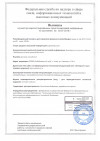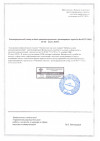Резюме
| Название статьи | МЕДИКАМЕНТОЗНАЯ КОРРЕКЦИЯ ПОВРЕЖДЕНИЙ ГЛИКОКАЛИКСА |
|---|---|
| Title | MEDICAL CORRECTION OF GLYCOCALYX DAMAGE |
| Категория | номер 2 за 2023 год (опубликован 10.07.2023) |
| Тип | Обзорная статья |
| Ключевые слова | гликокаликс, синдекан, гепарансульфат, 6-гидроксиэтилкрахмал, антитромбин III, медикаментозная коррекция |
| Keywords | glycocalyx, syndecan, heparan sulfate, 6-hydroxyethyl starch, antithrombin III, drug correction |
| Скачать | Скачать статью |
| doi | 10.52485/19986173_2023_2_131 |
| УДК | 616.94-07-08:577.152.3 |
| Резюме | Гликокаликс (ГК) представляет собой гелеобразный полисахаридно-белковый слой, покрывающий поверхность эндотелиальных клеток сосудов. ГК поддерживает гомеостаз сосудистой сети, в том числе контролирует проницаемость сосудов и тонус микрососудов, предотвращает микрососудистый тромбоз и регулирует адгезию лейкоцитов. Повреждение эндотелиального ГК является универсальным звеном патогенеза при различных патологических процессах. Многие хронические заболевания на этапе декомпенсации часто сопровождаются деградацией ГК, |
| Список литературы | 1. Fallacara A., Baldini E., Manfredini S., Vertuani S. Hyaluronic acid in the third millennium. Polymers (Basel). 2018. 10. 701. doi: 10.3390/polym10070701. |
| 2. Jedlicka J., Becke, B. F., Chappell D. Endothelial glycocalyx. Crit. Care Clin. 2020. 36. 217–232. doi: 10.1016/ j.ccc.2019.12.007. | |
| 3. Ince C., Mayeux P.R., Nguyen T., Gomez H., Kellum J.A., Ospina-Tascn G.A., Hernandez G., Murray P., De Backer D. The endothelium in sepsis. Shock. 2016. 45.259–70. doi: 10.1097/SHK.0000000000000473. | |
| 4. Patterson E., Cepinskas G., Fraser D. Endothelial Glycocalyx Degradation in Critical Illness and Injury. Sec. Intensive Care Medicine and Anesthesiology. 2022. 9. doi:10.3389/fmed.2022.898592. | |
| 5. Сокологорский С.В., Овечкин А.М., Политов М.Е., Буланова Е.Л. Восстановить гликокаликс! Есть ли возможности? Анестезиология и реаниматология. 2022. (1).102110. doi:10.17116/anaesthesiology2022011102. | |
| 6. Qu J., Cheng Y., Wu W., Yuan L., Liu X. Glycocalyx Impairment in Vascular Disease: Focus on Inflammation. Front. Cell Dev. Biol. 2021. 9. https://doi.org/10.3389/fcell.2021.730621 | |
| 7. Dogn S., Flamion B., Caron N. Endothelial glycocalyx as a shield against diabetic vascular complications. Arterioscler Thromb Vasc Biol. 2018. 38. 1427–39. doi: 10.1161/ATVBAHA.118.310839. | |
| 8. Pesta D., Roden M. The Janus Head of Oxidative Stress in Metabolic Diseases and During Physical Exercise, Curr Diab Rep. 2017. 17(6). doi:10.1007/s11892-017-0867-2. | |
| 9. Song J., Goligorsky M. Perioperative implication of the endothelial glycocalyx. Korean J Anesthesiol. 2018. 71(2).92-102. doi: 10.4097/kjae.2018.71.2.92. | |
| 10. Christina Drost C., Rovas A., Kmpers P. Protection and rebuilding of the endothelial glycocalyx in sepsis - science or fiction? Matrix Biology Plus. 2021. 12. 100091. doi: 10.1016/j.mbplus.2021.100091 | |
| 11. Song J.W., Zullo J.A., Liveris D., Dragovich M., Zhang X.F., Goligorsky MS. Therapeutic restoration of endothelial glycocalyx in sepsis. J Pharmacol Exp Ther. 2017. 361. 115-21. doi:10.1124/jpet.116.239509 | |
| 12. Lambadiari V., Mitrakou A., Kountouri A., Thymis J., Katogiannis K., Korakas E. Association of COVID-19 with impaired endothelial glycocalyx, vascular function and myocardial deformation 4 months after infection. Eur J Heart Fail. 2021. 23. 1916–26. doi: 10.1002/ejhf.2326. | |
| 13. Targosz-Korecka M., Kubisiak A., Kloska D., Kopacz A., Grochot-Przeczek A., Szymonski M. Endothelial glycocalyx shields the interaction of SARS-CoV-2 spike protein with ACE2 receptors. Sci Rep. 2021. 11. 12157. doi: 10.1038/s41598-021-91231-1. | |
| 14. Torres L.N., Chung K.K., Salgado C.L., Dubick M.A., Torres Filho I.P. Low-volume resuscitation with normal saline is associated with microvascular endothelial dysfunction after hemorrhage in rats, compared to colloids and balanced crystalloids. Crit Care. 2017. 21. 160. doi: 10.1186/s13054-017-1745-7. | |
| 15. Hariri G., Joffre J., Deryckere S., Big N., Dumas G., Baudel J-L. Albumin infusion improves endothelial function in septic shock patients: a pilot study. IntensiveCare Med. 2018. 44.669–71. doi: 10.1007/s00134-018-5075-2. | |
| 16. Barelli S., Alberio L. The role of plasma transfusion in massive bleeding: protecting the endothelial glycocalyx? Front Med. 2018. 5. 91. doi: 10.3389/fmed.2018.00091 | |
| 17. Uchimido R., Schmidt E., Shapiro N. The glycocalyx: a novel diagnostic and therapeutic target in sepsis. Crit Care. 2019. 23(1). 16. doi: 10.1186/s13054-018-2292-6. | |
| 18. Wu F., Peng Z., Park P. W., Kozar R. A. Loss of Syndecan-1 Abrogates the Pulmonary Protective Phenotype Induced by Plasma After Hemorrhagic Shock. Shock. 2017. 48(3). 340–345. doi: 10.1097/SHK.0000000000000832. | |
| 19. Deng X., Cao Y., Huby M.P., Duan C., Baer L., Peng Z., Kozar R.A., Doursout M.F., Holcomb J.B., Wade C.E., Ko T.C. Adiponectin in fresh frozen plasma contributes to restoration of vascular barrier function after hemorrhagic shock. Shock. 2016. 45(1). 50-54. https://doi.org/10.1097/SHK.0000000000000458. | |
| 20. Margraf A., Herter J.M., Khne K. 6% Hydroxyethyl starch (HES 130/0.4) diminishes glycocalyx degradation and decreases vascular permeability during systemic and pulmonary inflammation in mice. Crit Care. 2018. 22. 111. doi:10.1186/s13054-017-1846-3 . | |
| 21. Milford E.M., Reade M.C. Resuscitation fluid choices to preserve the endothelial glycocalyx. Crit Care. 2019. 23. 77. doi:10.1186/s13054-019-2369- x. | |
| 22. Smart L., Boyd C.J., Claus M.A., Bosio E., Hosgood G., Raisis A. Large-volume crystalloid fluid is associated with increased hyaluronan shedding and inflammation in a canine hemorrhagic shock model. Inflammation. 2018. 41. 1515–1523. doi:10.1007/s10753-018-0797-4. | |
| 23. Martin J.V., Liberati D.M., Diebel LN. Disparate effects of catecholamines under stress conditions on endothelial glycocalyx injury: an in vitro. Am J Surg. 2017. 214. 1166–1172. doi: 10.1016 /j.amjsurg.2017.09.018. | |
| 24. Job K.M., O’Callaghan R., Hlady V., Barabanova A., Dull R.O. The biomechanical effects of resuscitation colloids on the compromised lung endothelial glycocalyx. Anesth Analg. 2016. 123(2). 382–93. doi: 10.1213/ANE.0000000000001284 | |
| 25. Zhao H., Zhu Y., Zhang J., Wu Y., Xiang X., Zhang Z. The beneficial effect of HES on vascular permeability and its relationship with endothelial glycocalyx and intercellular junction after hemorrhagic shock. Front Pharmacol. 2020. 11. 597. doi: 10.3389/fphar.2020.00597. | |
| 26. Li X., Sun S., Wu G., Che X., Zhang J. Effect of hydroxyethyl starch loading on glycocalyx shedding and cerebral metabolism during surgery. J Surg Res. 2020. 246. 274–283. doi: 10.1016/j.jss.2019.09.030. | |
| 27. Smart L., Boyd C.J., Claus M.A., Bosio E., Hosgood G., Raisis A. Large-volume crystalloid fluid is associated with increased hyaluronan shedding and inflammation in a canine hemorrhagic shock model. Inflammation. 2018. 41. 1515–1523. doi: 10.1007/s10753-018-0797-4. | |
| 28. ElSaadani M., Ahmed S. M., Jacovides C., Lopez A., Johnson V. E., Kaplan L. J., Schwab C.W., Smith D. H., Pascual J. L. Antithrombin III ameliorates post-traumatic brain injury cerebral leukocyte mobilization enhancing recovery of blood brain barrier integrity. J. Trauma Acute Care Surg. 2021. 90(2). 274–280. doi: 10.1097/TA.0000000000003000. | |
| 29. Targosz-Korecka M., Malek-Zietek K.E., Kloska D., Rajfur Z., Stepien E. u., Grochot-Przeczek A., Szymonski M. Metformin attenuates adhesion between cancer and endothelial cells in chronic hyperglycemia by recovery of the endothelial glycocalyx barrier. Biochim. Biophys. Acta, Gen. Subj. 2020. 1864 (4). 129533. doi: 10.1016/j.bbagen.2020.129533. | |
| 30. Brettner F., Chappell D., Nebelsiek T., Hauer D., Schelling G., Becker B.F. Preinterventional hydrocortisone sustains the endothelial glycocalyx in cardiac surgery. Clin Hemorheol Microcirc. 2019. 71. 59–70. doi: 10.3233/CH-180384. | |
| 31. Lindberg-Larsen V., Ostrowski S.R., Lindberg-Larsen M., Rovsing M.L. Johansson P.I., Kehlet H. The effect of pre-operative methylprednisolone on early endothelial damage after total knee arthroplasty: a randomised, double-blind, placebo-controlled trial. Anaesthesia. 2017. 72. 1217–24. doi: 10.1111/anae.13983 | |
| 32. Pesonen E., Keski-Nisula J., Andersson S., Palo R., Salminen J., Suominen P.K. High-dose methylprednisolone and endothelial glycocalyx inpaediatric heart surgery. Acta Anaesthesiologica Scandinavica. 2016. 60(10). 1386-1394. https://doi.org/10.1111/aas.12785 | |
| 33. Patterson E., Cepinskas G., Fraser D. Endothelial Glycocalyx Degradation in Critical Illness and Injury. Sec. Intensive Care Medicine and Anesthesiology. 2022. 9. doi:10.3389/fmed.2022.898592. | |
| 34. Kim H.J., Lee B., Lee B.H., Kim S.Y., Jun B., Choi Y.S. The effect of tranexamic acid administration on early endothelial damage following posterior lumbar fusion surgery. J Clin Med. 2021. 10. 1415. doi: 10.3390/jcm10071415 | |
| 35. Anderson T.N, Hinson H.E., Dewey E.N., Rick E.A., Schreiber M.A., Rowell S.E. early tranexamic acid administration after traumatic brain injury is associated with reduced syndecan-1 and angiopoietin-2 in patients with traumatic intracranial hemorrhage. J Head Trauma Rehabil. 2020. 35. 317–23. doi: 10.1097/HTR.0000000000000619. | |
| 36. Diebel M.E., Martin J.V., Liberati D.M., Diebel L.N. The temporal response and mechanism of action of tranexamic acid in endothelial glycocalyx degradation. J Trauma Acute Care Surg. 2018. 84. 75–80. doi: 10.1097/TA.0000000000001726 | |
| 37. Buijsers B., Yanginlar C., de Nooijer A., Grondman I., Maciej-Hulme M.L., Jonkman I. Increased plasma heparanase activity in COVID-19 patients. Front Immunol. 2020. 11. 2572. doi: 10.3389/fimmu.2020.575047 | |
| Resume | Glycocalyx (GC) is a polysaccharide-protein gel-like layer on the luminal side of blood vessels. GC supports homeostasis of the vascular network, including controls vascular permeability and microvascular tone, prevents microvascular thrombosis and regulates leukocyte adhesion. Damage of GC is a universal link of pathogenesis in various pathological processes. Many chronic diseases at the stage of decompensation are often accompanied by degradation of GC caused by inflammatory reactions, hypoperfusion, shock, which leads to disruption of microcirculatory perfusion and organ dysfunction. Drug prevention and treatment of GC damage, as well as the possibility of its recovery, are promising areas of research. This review analyzes the main mechanisms of GC destruction, as well as methods of medical correction of GC damage. In animal experiments, the possibilities of restoring HA using an infusion of albumin and freshly frozen plasma are described. In preclinical and clinical studies, the use of glucocorticoids, sulodexide, 6-hydroxyethyl starch, antithrombin III, in various pathological conditions, was considered in order to correct the dysfunction of GC. Pharmacological correction of GC disorders is still far from being fully resolved and is at the stage of clinical research, which requires additional scientific work on this topic. |
| Автор 1 | Воробьёва Анна Павловна |
| Автор 2 | Быков Юрий Витальевич |
| Автор 3 | Батурин Владимир Александрович |
| Автор 4 | Муравьёва Алла Анатольевна |



